
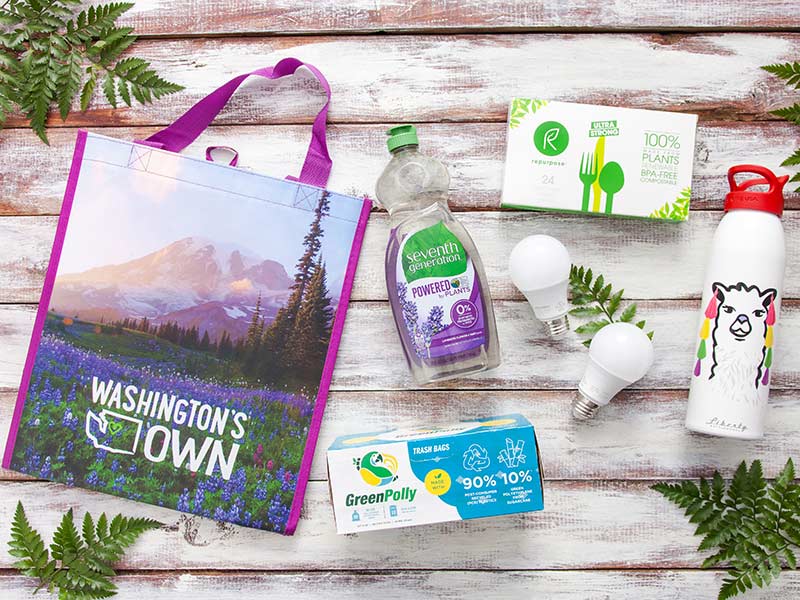
It’s Earth Day, and in a world now where nearly all of us on lockdown, we’re seeing crystal clear canals in Venice and air pollution dropping by as much as 60% in areas like the UK and 40% in China. Some good news! But tough tough questions remains to be seen, including – Will we carry some of these lessons with us after lockdown? What can each of us do to help eliminate some of the excess? In the first of our Eco-blog series, we’ll focus on one particular culprit: Plastic.
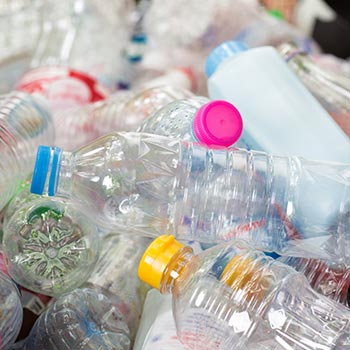 Reduce. So many of us hear it, and yet it’s a hard one to put into practice. If you’re looking to reduce your plastic consumption, consider starting with one huge culprit out there – plastic water bottles.
Reduce. So many of us hear it, and yet it’s a hard one to put into practice. If you’re looking to reduce your plastic consumption, consider starting with one huge culprit out there – plastic water bottles.
We know plastic water bottles come in handy. They’re useful for things like emergency kits, when tap water is unsafe to drink, or even when you’ve forgotten to bring water on your hike. For your everyday hydration, we recommend you try swapping your bottled water for a reuable one, and sticking with good old-fashion tap water!
Isn’t bottled water cleaner water though? Actually, that might not be true. Studies show that nearly half of all bottled water is bottled directly from the tap. Plastic bottles also contain microplastics. One study done in 2018 shows that after testing 11 global brands of bottled water, 93% of the bottles tested showed contamination from microplastics. Another factor to consider, when plastic bottles are thrown into the trash and end up in landfills, they eventually break down into microplastics which end up in our ground water or oceans, which eventually then ends up – in us.
Speaking of landfills, did you know that every day in the US, 60 million plastic water bottles are thrown into the trash! On average, less than half of plastic water bottles end up at the recycling center, and from that, only 7% ever gets turned into another water bottle.
Here is just one of many great videos that provides some more detail in you’re interested.
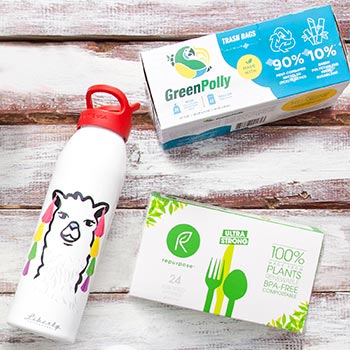 Plastic water bottles, of course, aren’t the only culprits of our growing landfills. The buildup of toothbrushes is one of the more recently trending article topics. There are many great alternatives out there to help eliminate our plastic use, such as bamboo toothbrushes, metal straws, compostable knives and forks for takeout or picnics, reusable water bottles, and reusable coffee mugs. (Spoiler alert: most disposable coffee mugs are lined with a thin plastic lining to help prevent the beverage from seeping into the paper, which make them non-compostable.) And for some reason, even though we’re told that plastic should stay out of the garbage as much as possible, our garbage bags are made of – what’s that again? Oh that’s right – plastic. Several companies are on board trying to help eliminate this by making compostable trash bags as well as compostable doggie poop bags. Plastic water bottles, of course, aren’t the only culprits of our growing landfills. The buildup of toothbrushes is one of the more recently trending article topics. There are many great alternatives out there to help eliminate our plastic use, such as bamboo toothbrushes, metal straws, compostable knives and forks for takeout or picnics, reusable water bottles, and reusable coffee mugs. (Spoiler alert: most disposable coffee mugs are lined with a thin plastic lining to help prevent the beverage from seeping into the paper, which make them non-compostable.) And for some reason, even though we’re told that plastic should stay out of the garbage as much as possible, our garbage bags are made of – what’s that again? Oh that’s right – plastic. Several companies are on board trying to help eliminate this by making compostable trash bags as well as compostable doggie poop bags. |
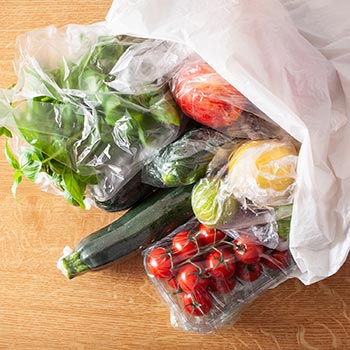 Reuse: Reusable bags! We’ve heard about these for years and see them at all the grocery stores. But are reusable bags really that much better than just grabbing 10 or 20 single use bags?
Reuse: Reusable bags! We’ve heard about these for years and see them at all the grocery stores. But are reusable bags really that much better than just grabbing 10 or 20 single use bags?
Most studies are in agreement that the standard reusable bags you see (and probably have) should be used at least 35 times before they break even, whereas paper should be used 4 times and plastic bags reused just once.
But hold on, doesn’t that mean single use plastic bags are the best ones? Well, no. Although plastic bags are technically recyclable, they can’t be put in your normal recycling bin because they tend to jam up the machines at the recycling center. And though most larger grocery stores have bag recycling deposits, only 1% of plastic bags are ever recycled. Many people do actually reuse their plastic bags – as garbage bag liners – which then, of course, end up in the landfill anyway. So, ultimately, the best option is a reusable tote bag, but only if you actually intend to use it. In a study done in the UK, it was found that 40% of shoppers usually forget to bring their reusable bags, which then leads them to come home with several new single-use bags instead.
One incredibly easy thing to change about grocery shopping is to eliminate the use of those thin, wispy plastic bags that you put your fruit and veggies in. If you’re afraid of germs from the grocery cart touching your food, don’t fret! Things like oranges, bananas, and onions have natural shields with their peels. No need for a plastic bag here. Buying apples, zucchinis, asparagus, or any other fruit or veggie with a skin? These don’t need a plastic lining either. It is recommended that fruit and veggies should be washed before eating anyway, eliminating germs not just from the grocery cart but also from any hands that touched them during distribution as well as remaining pesticides. As for smaller items in bunches, like brussel sprouts or beans, a quick and easy change is to put these in the paper bags used for mushrooms. Or, there are also reusable types on the market meant for bulk items.
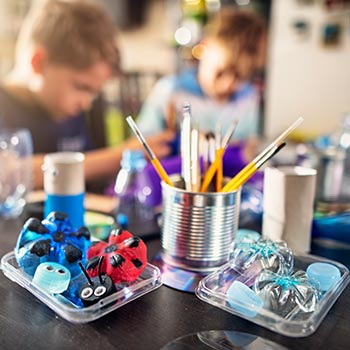 Recycle: Yes, recycle! But unfortunately a lot of us partake in what’s called “wish-cycling.” Which is exactly what it sounds like. We throw plastic in any shape or form into the recycling bin, hoping and wishing that regardless of what it was, it gets melted down and turned into something new. Sadly, that’s not the case. Different communities are served by different recycling centers, and not all recycling centers are created equal. It’s extremely important to know what you can and can’t recycle in your own neighborhood to prevent clogging machines and having a backlog of sorting. Then you can work to eliminate purchasing the types of plastic that aren’t recyclable in your area. For those in King County, this is a great resource to get you started.
Recycle: Yes, recycle! But unfortunately a lot of us partake in what’s called “wish-cycling.” Which is exactly what it sounds like. We throw plastic in any shape or form into the recycling bin, hoping and wishing that regardless of what it was, it gets melted down and turned into something new. Sadly, that’s not the case. Different communities are served by different recycling centers, and not all recycling centers are created equal. It’s extremely important to know what you can and can’t recycle in your own neighborhood to prevent clogging machines and having a backlog of sorting. Then you can work to eliminate purchasing the types of plastic that aren’t recyclable in your area. For those in King County, this is a great resource to get you started.
But recycling doesn’t only have to describe what goes into the bins. Gallon milk jugs can be cut open to make a sand box shovel, a bird feeder, or even putting faces on them and lights in them for a ghostly walkway for Halloween. Bottle caps can be used for a child’s art project, Costco-sized coffee or almond containers can be used for mini kitchen composting bins, and all sorts of different shaped plastics can be painted and used as a fun kids gardening project.
The ways in which we can reduce our plastic intake are nearly limitless. And while it sounds ideal to just eliminate plastic altogether, it’s not very feasible – at least in today’s world. What is feasible is that we can all make a small effort where we can. And if each of us did just a little, or maybe just a little more than what we already are, the impact of our efforts can be wide-scale. They say the first step to recovery is realizing you have a problem. Once we’ve admitted we have a plastic problem, we can work together on the road to earth’s recovery.
For some eco-friendly products to get you started, we stock these amazing companies at your local Bartell’s:
BioBag – Compostable garbage bags, sandwich and snack bags, and doggie poop bags
Repurpose – Plant-based cups, plates, utensils, and straws
Stanley – Reusable mugs, and Seattle-based!
Liberty Bottles – Reusable water bottles, also Seattle-based!
Green Toys – BPA and Phthalate-free plastic toys from 100% recycled plastic
Norpro and Silver One – Stainless steel straws
Wow Bamboo – Bamboo toothbrushes
Tom’s of Maine – All natural toothpaste in recyclable tubes, plus other natural product
Green Polly – Trash bags made from 80%-90% post consumer recycled plastic and 10%-20% green polyethylene made from sugar cane



